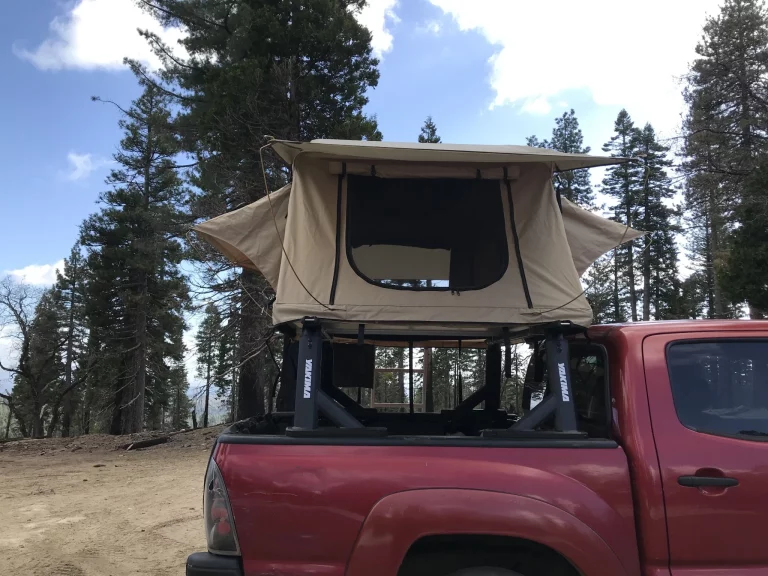Clamshell roof top tents have gained popularity in the camping world due to their innovative design and easy setup. But a common question that campers often ask is, “Are clamshell top tents waterproof?” In this inclusive article, we will cover the waterproofing capabilities of roof top tents, addressing concerns and providing insights into their construction and performance in wet conditions.
Aware Clamshell Roof Top Tents
Before we explore the waterproofing aspect, it’s crucial to aware what clamshell top tents are and how they work. These tents are characterized by their unique clamshell-style opening, which allows them to open upwards, much like the shell of a clam. This design offers quick and easy access to your camping shelter.
Materials and Construction
Manufacturers typically construct clamshell top tents with a durable, waterproof outer shell made of materials such as fiberglass, aluminum, or reinforced plastic. The shell serves as both the protective cover during transit and the sturdy base when opened for camping. Beneath the shell, you’ll find the tent’s fabric canopy, which provides the actual living space.
Waterproofing Considerations
Now, let’s explore the key factors that determine the waterproofing capabilities of roof top tents.
1. Outer Shell Material
The material used for the outer shell of roof top tents plays a crucial role in their waterproofing. We choose high-quality materials for their ability to repel water effectively. We often reinforce these materials with waterproof coatings or treatments to enhance their performance in wet conditions.
2. Canopy Material
Like other types of tents, the canopy material of Clamshell roof top tents is vital for keeping occupants dry. Quality tents use materials such as ripstop nylon or canvas, which have inherent water-resistant properties. Additionally, manufacturers may apply waterproof coatings or treatments to the canopy to further enhance its waterproof capabilities.
3. Sealing and Weatherproofing
Proper sealing and weatherproofing are essential for preventing water from entering the tent. Manufacturers pay close attention to seams and entry points, using waterproof seam tape and sealants to reinforce these areas. Effective sealing around zippers, windows, and other openings is crucial to ensure a watertight seal.
4. Rain Fly
Some clamshell top tents come equipped with a built-in rain fly or awning. This feature provides an extra layer of protection against rain and helps divert water away from the tent’s entrance. A well-designed rain fly can significantly enhance the tent’s waterproofing capabilities.
Clamshell Roof Top Tents vs. Rain and Other Elements
Clamshell top tents are designed to offer excellent protection against rain and other elements. Here’s how they perform in various weather conditions:
Rain
Clamshell top tents excel at keeping occupants dry during rain showers. The combination of a waterproof outer shell, quality canopy material, effective sealing, and, in some cases, a rain fly ensures that water is shed away from the tent’s interior. These tents are a reliable choice for camping in wet weather.
Snow
Clamshell roof top tents are suitable for use in snowy conditions, provided they are designed and rated for such weather. Clearing snow accumulation on the outer shell is easy, and the insulated canopy materials help in maintaining a comfortable interior temperature.
Wind
Most roof top tents are designed to withstand moderate to strong winds. The rigid outer shell and robust construction contribute to their stability in windy conditions. However, as with any tent, extreme winds can pose challenges, so it’s advisable to choose a sheltered campsite when necessary.
Frequently Asked Questions
Q1: Can I apply additional waterproofing to my roof top tent?
A1: While these tents are generally designed to be waterproof, you can enhance their water resistance by applying a waterproofing spray or treatment to the outer shell and canopy. Ensure that the products you use are compatible with the materials and coatings of your tent.
Q2: What maintenance do I need to perform to ensure my roof top tent remains waterproof?
A2: Regularly inspect your tent for any signs of wear, tear, or damage. Clean it according to the manufacturer’s guidelines, paying attention to seam integrity and sealing. Proper storage when not in use can also help extend the tent’s lifespan.
Q3: Can I use my roof top tent in heavy rain without concerns?
A3: While these tents are designed to handle rain effectively, it’s advisable to exercise caution during heavy downpours, especially if strong winds accompany them. Setting up in a sheltered location and using a rain fly, if available, can provide additional peace of mind.
Q4: Are roof top tents suitable for extended camping trips in various weather conditions?
A4: Yes, clamshell roof top is suitable for extended trips, including those in diverse weather conditions. However, it’s important to choose a tent that matches your specific needs and expected climate. Some tents are designed for four-season use, making them suitable for year-round adventures.
Conclusion
In conclusion, clamshell roof top tents are generally designed to be waterproof and provide a reliable camping experience in various weather conditions. Their construction, including the quality of materials, sealing, and optional rain fly, plays a pivotal role in their ability to keep you dry and comfortable during outdoor adventures. Whether you’re camping in the rain, snow, or under windy skies, a well-maintained roof top tent can be your trusty shelter amidst the elements.
Tags: Clamshell Roof Top Tent, Overlander Roof Top Tent

